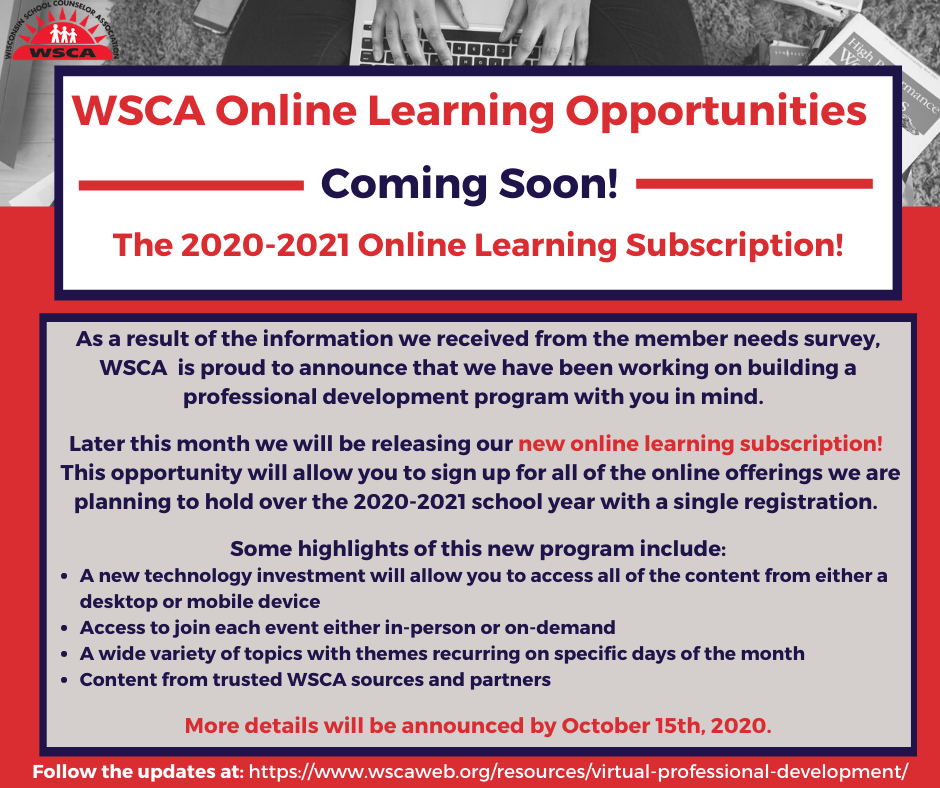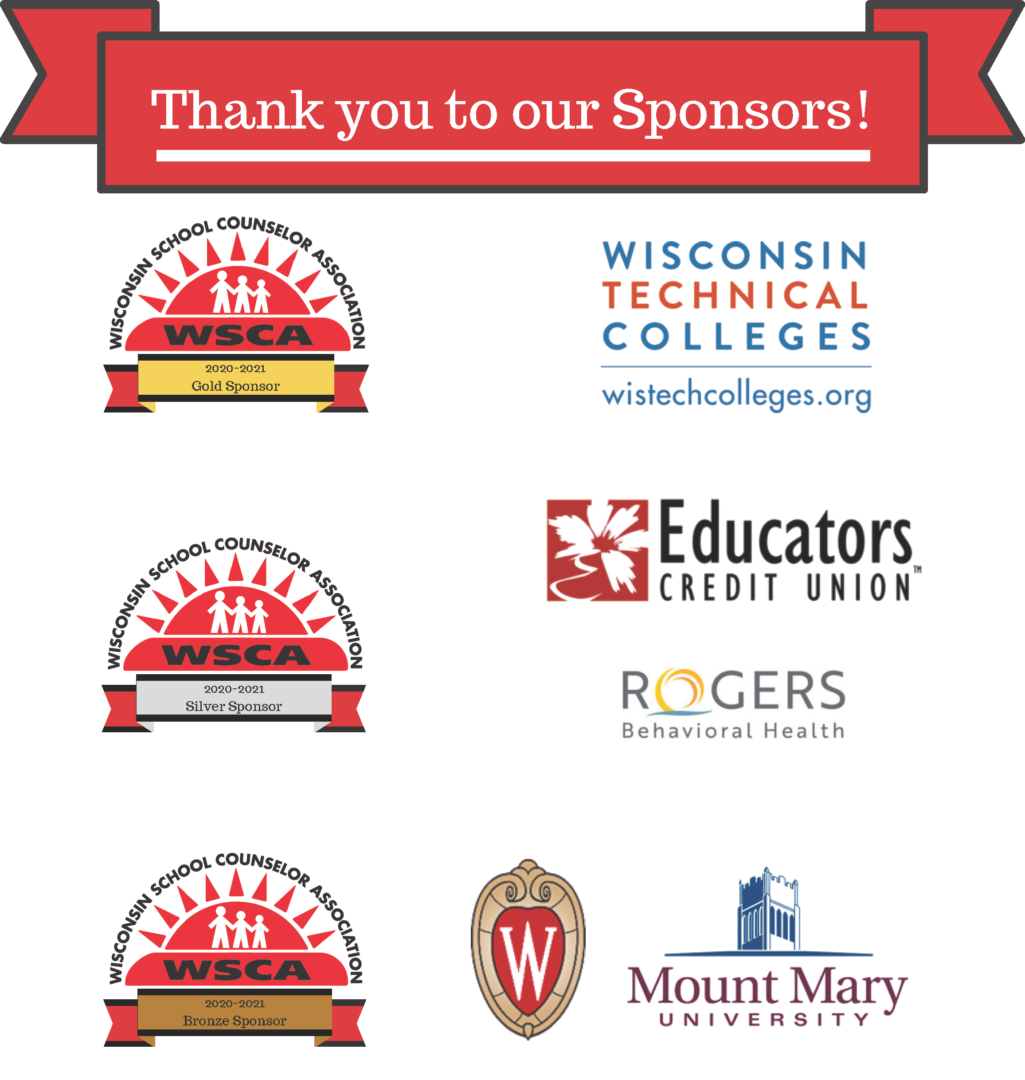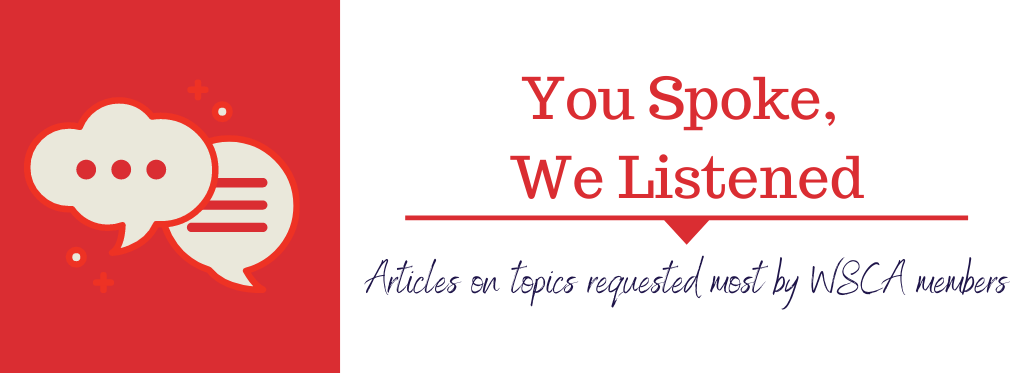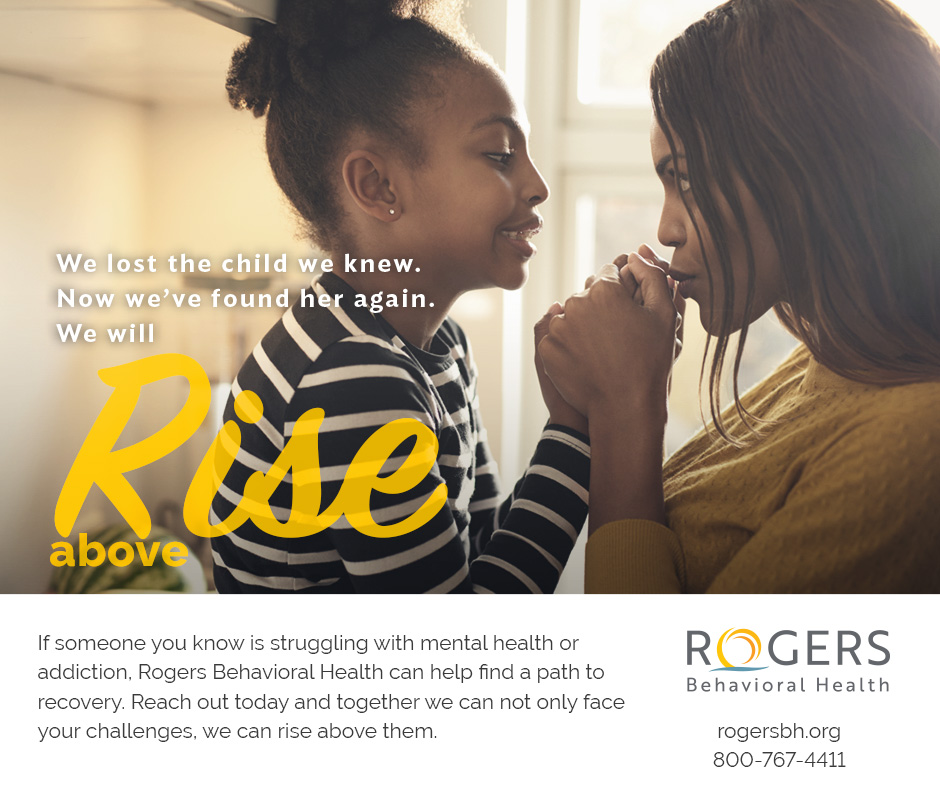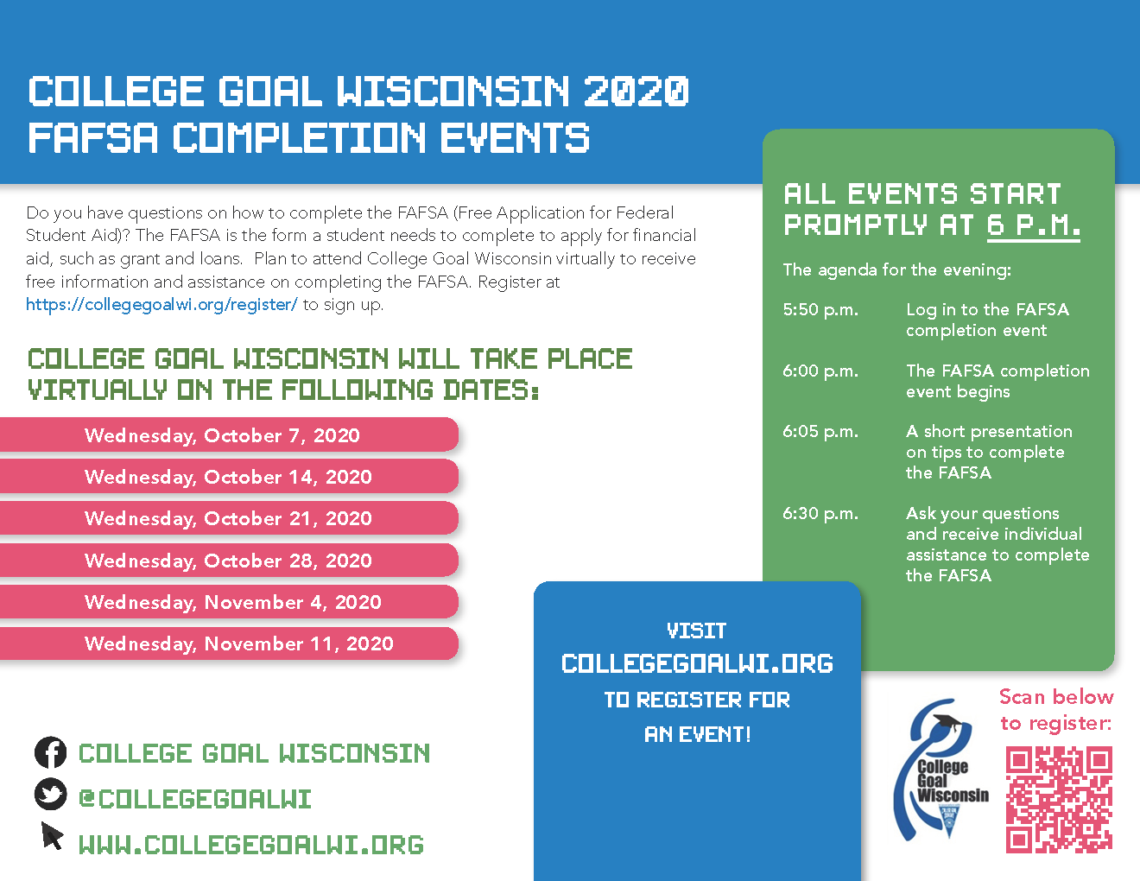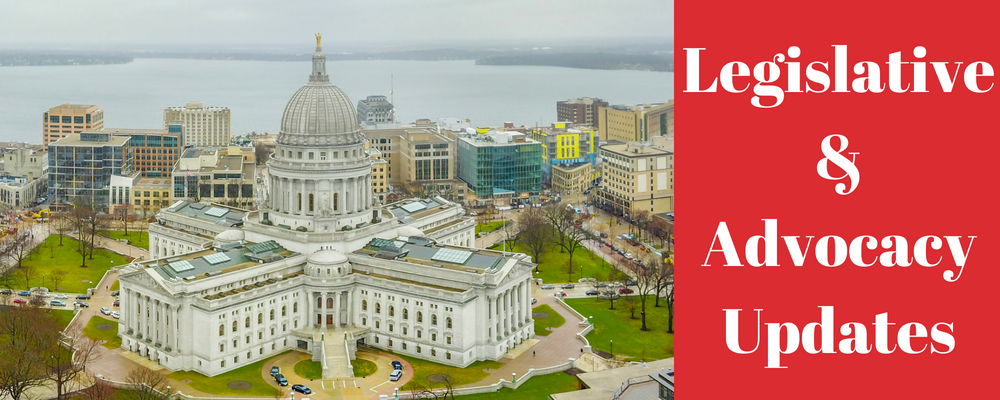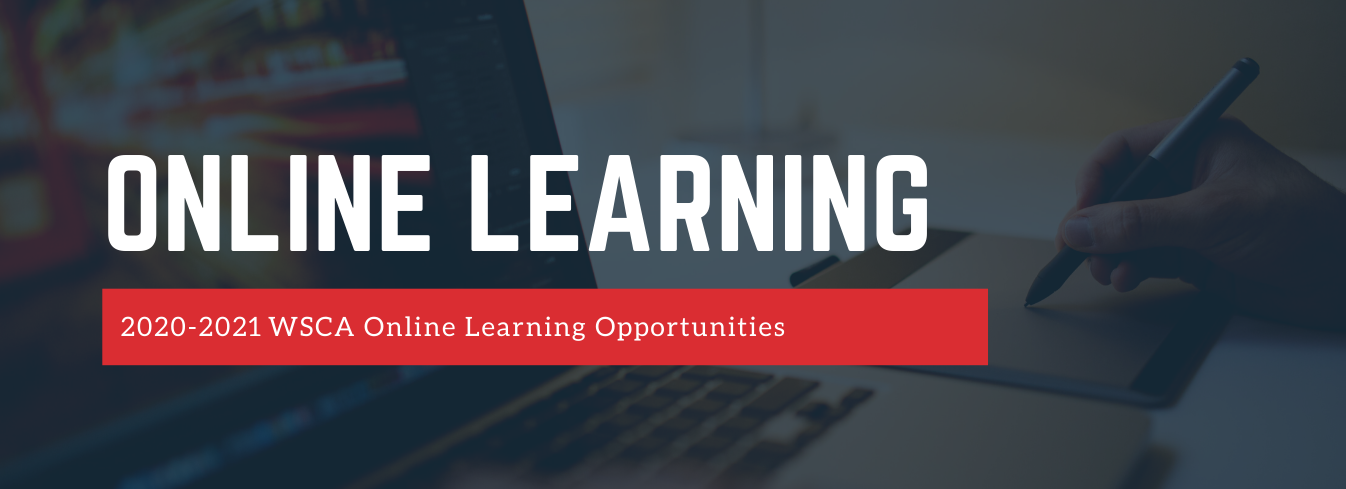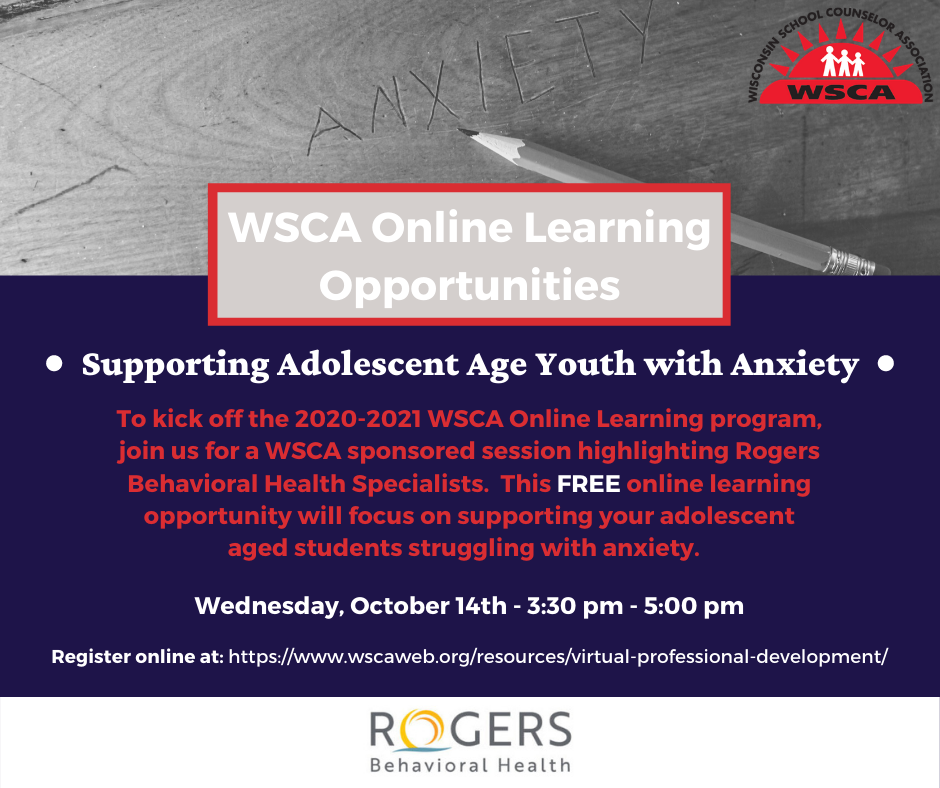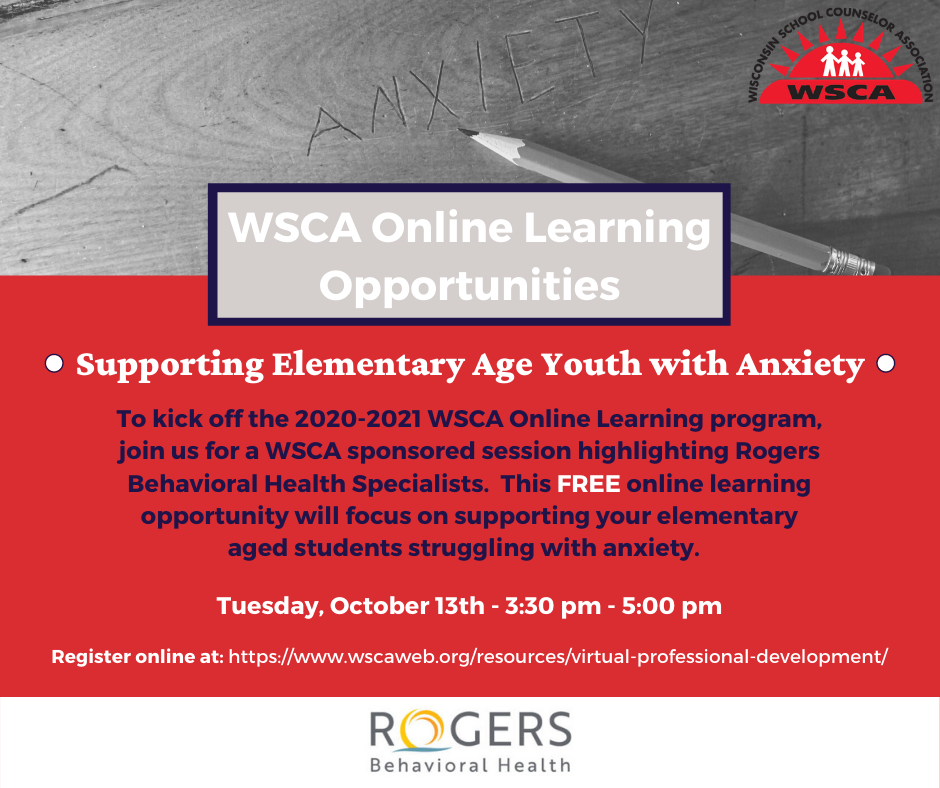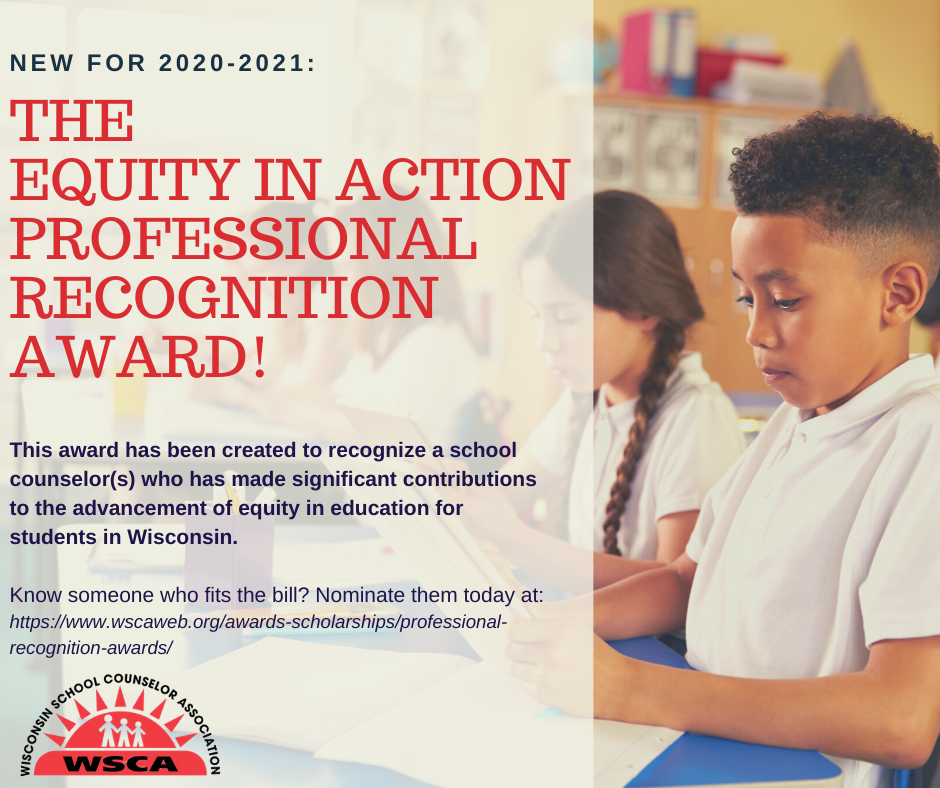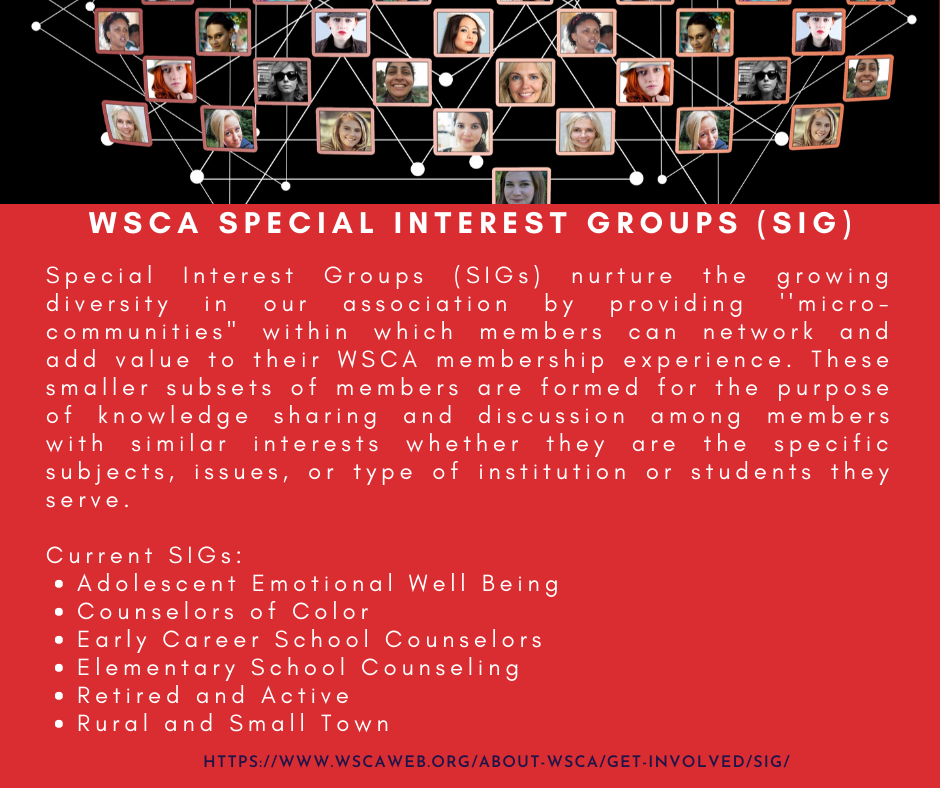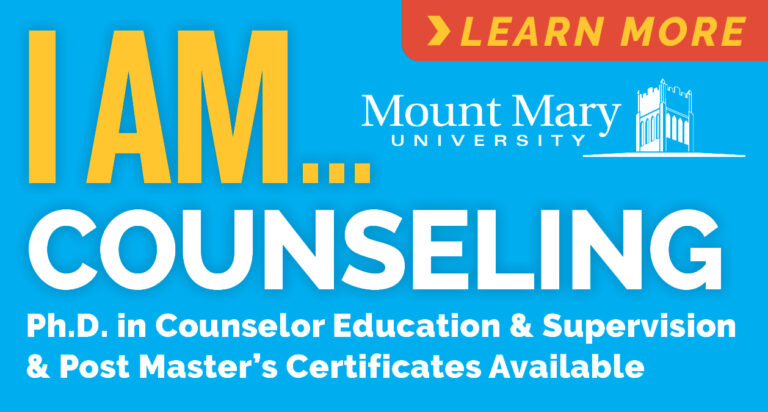October 2020

In This Issue:
- A Message from the Department of Public Instruction
- Coming Soon: The WSCA 2020-2021 Online Learning Subscription
- A Message from the Board of Directors
- Thank you to our Sponsors!
- Feature Article – Social Emotional Learning
- No Fees Attached College Access Month
- You Spoke, We Listened – Social-Emotional Well-Being: Social and Emotional Learning: A Lever for Building Hope and Resilience
- Equity & Social Justice: Equitable Post-Secondary Access
- College & Career Readiness: Keeping College Affordable
- College Goal Wisconsin 2020
- Legislative Update – DPI Proposed Changes to PI 34 Update
- Online Learning: Supporting Students with Anxiety Free Events
- Upcoming Events & Committee Updates – Save the Date for our NSCW Breakfast Event!
- Professional Recognition Nominations Open
- New Award: Equity in Action
- Special Interest Groups
- WSCA Committees Need YOU!
Forward to Retirement
Gregg C. Curtis, PhD
Education Consultant; School Counseling and Suicide Prevention
Co-Lead; Academic and Career Planning
Wisconsin Department of Public InstructionDear WSCA members,
I wanted to share with you that I’m retiring from DPI. It has been a humbling honor to serve as your consultant the last 8 years; and I have really loved working for you, learning from you, and leading beside you. We have done some wonderful things, and there is still much work to do with our students, our families, and our profession. I am extremely hopeful that the talent pool to replace me will be deep. If you are interested at all in state-level work, I highly recommend this position on the Student Services/Prevention and Wellness Team. My colleagues are some of the most dedicated, knowledgeable, and passionate professionals I’ve ever met. Take good care of yourselves and your loved ones as we all find our ‘new normal.’
As former State Superintendent Tony Evers used to say of all educators, “You are on the side of angels.”
Stay healthy, safe, and positive.
~Gregg Curtis
Amy Everson, Board Member
School Counselor, River Falls, WIAs we start this unique school year, we as school counselors are being challenged in many ways. We have been tasked with the role of supporting our students as they return to school after six months of being away, either in person or virtually. This support includes SEL through small groups, classroom lessons, individual counseling and all through a very creative lens considering the safety measures to combat COVID-19. Our lessons have been adjusted to include behavior expectations regarding wearing a mask, hand washing, and social distancing. The connections we make with our students either behind a mask or behind a screen, will be even more important to their success this year and will no doubt be more challenging.
We are also given the responsibility of supporting our fellow staff members to build resilience so that we can all show up emotionally ready to teach and support our students this Fall. Let’s not forget this resilience work is needed for us, too. In order for us to support our students, families, and staff we must make our own mental health a priority. I am currently reading and co-leading a book study for my staff from Onward: Cultivating Emotional Resilience in Educators by Elena Aguilar. The author says, “Practicing mindfulness is like hitting the internal pause button on the drama of life” (p.127). We must pause throughout or work day to step back, notice without judgement, and make the next best decision.
The WSCA board of directors has focused our learning on equity this past year, as many of you have also done both personally and professionally. A connection I made while reading Aguilar’s book to our equity work with Robin DiAngelo’s book, White Fragility was in regards to mindfulness. When we go throughout our day un-consciously or un-mindfully, we participate in implicit bias. On the other hand, when we are mindful and conscious of our thoughts and pause, we become aware of the implicit bias that exists within us. In turn, giving us the opportunity to change. Berkeley professor John A. Powell (2015) says, “The unconscious mind is partially the source of today’s new order of racial discrimination and bias” (p.135).
I am thankful for the learning we have and will continue to do as a board, but also the learning I do with my colleagues in my district. My goal this year is to build my resilience and capacity for mindfulness so that I can both support others and be aware of my surroundings, my thoughts, and be open to changing the course of my implicit bias when it pops up. I believe this is how we can help change our culture and communities, by starting with ourselves.
~Amy Everson
Social Emotional Learning
Tiffany Schuette
School Counselor, New Holstein ElementarySocial Emotional Learning, in the wake of COVID-19, is more important now than ever. Whether your school year started face-to-face or virtually, you have students that sustained some form of trauma. Students fear getting the virus, spreading it to their loved ones – especially their grandparents, are more worried about germs, and have been out of a regular routine since March. We will continue to see the students we typically saw on a regular basis as school counselors but now we also have an increased number of students to meet with one-on-one due to trauma sustained by COVID-19.
The Wisconsin Department of Instruction released the Social Emotional Learning (SEL) Guidebook and competencies in May of 2018. Since then, schools have been implementing research-based SEL programs. Studies show (CASEL.org; McClelland et al., 2013) that SEL can benefit a school by the following: Students who develop and maintain friendships are less likely to engage in bullying. Students who manage their emotions by age five are more likely to graduate college. Schools that integrate SEL have shown increases in academic test scores by 11 points. That is an excellent sell for your administration!
How does SEL assist students with the difficult struggles of COVID-19? Students that receive a regular SEL curriculum can benefit in a variety of ways. SEL integration helps students build relationships both from student to student and teacher to student. It also creates a caring community culture, where classrooms thrive, by developing empathy and understanding for their fellow classmates. SEL teaches coping mechanisms, as well as social and problem-solving skills. Regular use of an SEL curriculum promotes self-regulation when experiencing intense emotions, teaches life skills, and builds resilience. All of the mentioned are so very important for our students in our current society.
Social Emotional Learning is also a BY ALL, FOR ALL approach. SEL might be a tough sell with staff. They may feel that they are overloaded and have too much already on their plate. This is a very real feeling educators are experiencing, and it is understandable that staff feel this way. However what they may not yet realize is that SEL is the plate. If teachers deliver an SEL curriculum, their classroom will be much more manageable if students have empathy towards one another and negative behaviors less likely to occur if they can self-regulate their emotions.
What SEL looks like in every school is different. At my elementary school in New Holstein, we approach SEL with a few interventions. Our teachers deliver the research-based curriculum Caring School Community. Students still receive my regular guidance curriculum I deliver bi-weekly. The occupational therapist and I have also implemented Zones of Regulation in all grades 4K-5 and all students receive an annual Zones lesson. We also offer Girls on the Run (GOTR) for girls in grades 3-5. GOTR is a non-profit organization where girls receive a 10 week SEL curriculum delivered by trained coaches.
Through implementing SEL we are truly doing all we can to meet the needs of students and help them gain important non-technical employability skills that employers look for in our future employees.
Social and Emotional Learning: A Lever for Building Hope and Resilience
Beth A. Herman, MSE
School Mental Health Training Consultant
Wisconsin Department of Public InstructionThe last six months have yielded profound changes in the way we go about our lives. The pandemic, social unrest, fight for equality, and persistent uncertainty have truly tested the resilience of our students, families and educators. The Harvard Center on the Developing Child (HCDC) defines resilience as a balance between the risk factors of adversity and the protection factors that mitigate those risks. Furthermore, the HCDC distills the current extensive research on resiliency into four protective factors that can buffer people from the negative effects of adverse situations and environments:
- Facilitating supportive adult-child relationships;
- Building a sense of self-efficacy and perceived control;
- Providing opportunities to strengthen adaptive skills and self-regulatory capacities; and
- Mobilizing sources of faith, hope, and cultural traditions.
Such a focus on building resiliency, rather than on negative events, is an act of hope, which is something we can all use a little more of these days. And in fact, hope prepares us to cope better with adversity. Making SEL a priority through intentional and explicit actions reduces the effects of adversity and creates a space where human connection and hope can grow.
Leveraging SEL to build student and adult resilience requires rededicating our focus on skill building, skill promotion, and creating safe and supportive environments for all. To that end, some high-yield resources and suggestions for implementing SEL in virtual and blended environments are presented below.
Promoting SEL Skills in Multiple Learning Environments
Social and emotional learning skill development occurs in two distinct ways: 1) explicit skill instruction and 2) Creating safe and supportive learning environments where SEL skills are practiced and promoted.
An evidence-based curriculum can provide the tools necessary for SEL explicit instruction and, notably, many curriculum providers have pivoted quickly to provide their materials online and for free during this unusual time. The SEL Providers Council-Free Covid 19 E-Learning Resources is another great resource for virtual SEL lessons and activities. Direct teaching of skills can also occur by integrating SEL skills into academic instruction. Activities such as journaling using prompts focused on SEL, and using literature to process the emotions of characters, problem solving and examining social and societal norms are just a few ways to knit together SEL competencies, the classroom, and everyday life.
Explicit SEL instruction is only one part of SEL skill development. Creating safe environments, whether virtual or in person, is also key, and it requires making and maintaining connections. Using morning meetings and CASEL’s 3 SEL Signature Practices, for example, can help to build community and provide predictability during this uncertain time. This Mapping Tool can also be helpful in ensuring that all students connect with a trusted adult.
Prioritizing Which SEL Skills to Focus On
What SEL skills are most in need of focused attention? The Gauge and Prioritize SEL Skills tool on the Wisconsin Department of Public Instruction (DPI) website can guide grade-level discussions to determine SEL priorities. SEL competence assessment is another way to determine SEL skill instruction needs. The SEL Assessment webpage and the Wisconsin SEL Development Tracker can connect you to SEL competence assessment tools, aligned with the Wisconsin SEL Competencies, to determine instructional needs.
Maya Angelou once said “You may not control all the events that happen to you, but you can decide not to be reduced by them.” We can choose to approach this unprecedented time as an opportunity to foster resilience rather than focus on the adversity that is swirling around us. Let us set an intention to purposefully build the social and emotional wellbeing of our students and ourselves.
Check out this page for a comprehensive list of SEL resources.
Harvard Center on the Developing Child.(n.d.). Resilience. https://developingchild.harvard.edu/science/key-concepts/resilience/
Angelou, M. (2008). Letter to My Daughter. New York, NY: Random House
Equitable Post-Secondary Access
Stacy Eslick, Wisconsin School Counselor AssociationApplying for college and having the financial resources for post high school education (FAFSA) are two legs of the stool for students achieving their post secondary plans. The theme of this month’s WSCAink is on the critical importance of Social Emotional Learning. Strong social emotional skills are critical to a students ability to not only apply and be admitted to college but to persist to post-secondary degree/certificate completion (elementary and middle school counselors are the ones building the foundation for these skills to be applied in high school and beyond!). Students need to have problem solving and communication skills to navigate the complex steps and systems necessary for post secondary education.
How do counselors provide equitable access to ALL students to obtain a post secondary education? With comprehensive school counseling programs we provide resources and information about post secondary planning universally to all students and families. We also have the ethical responsibility to provide additional support to students that need extra help to access resources to create and implement post secondary plans.
The National College Access Network shares that “Millions of students do not complete the FAFSA, and as a result, leave roughly $24 billion in federal student aid on the table each year (Kofoed, 2016). By simply completing this form, students are 63 percent more likely to attend a postsecondary institution (NCAN, 2017a). However, many students do not complete the form because they are misinformed or completely uninformed about federal student aid (NCAN, 2016).”
Counselors can share countless stories about how application fees, deposits, transcript fees, etc have kept our students from accessing their post high school plans. As a counselor how do you ADVOCATE and create system change for students that may not know how to navigate resources available to help them overcome barriers? Below is a modified version of recommendations created from states that have increased post secondary access.
Recommendations:
- Make low-income students the center of initiatives.
- Foster as many partnerships as possible.
- Invest in college access professional development and support.
- Collect data on FAFSA completion to raise accountability for initiatives. All Wisconsin public schools now have access to student level FAFSA data (https://dpi.wi.gov/wisedash/districts/about-data/FAFSA). Design FAFSA completion initiatives according to the target population’s needs. Start raising awareness about the FAFSA early.
- Provide sufficient and easily accessible resources on organization websites.
Many counselors have asked about supporting seniors during COVID. The first step is to give students hope that they can achieve their post secondary goals. Reflect on the above recommendations and how they are incorporated into your counseling and/or ACP program. How are you pivoting and sharing resources in the age of COVID? How are you systematically following up with students that need a gentle nudge, a little extra support, or just some encouragement that they can in fact access education after high school. What data do you need to collect to ensure that students not only have a plan but the ability and resources to take the necessary steps to put the plan into action.
WSCA is working closely with our partners to support equity and access for students post secondary plans. The Wisconsin Technical College System and UW System Schools have waived application fees in October. College Goal Wisconsin is providing FAFSA completion support by Financial Aid experts for free. Professional development for counselors will be offered through the new WSCA Online Learning service.
We look forward to joining you to support the class of 2021!!
Keeping College Affordable
Wisconsin Technical College SystemTo help celebrate and highlight the affordability of technical college, many of Wisconsin’s technical colleges are waiving the application fee during the month of October. Some people argue that a four-year education is a necessity at any cost. Higher education is the second biggest source of consumer debt after mortgages, topping 1.6 trillion dollars in student loan debt. Still, many parents and students also pay for the traditional college experience, bragging rights, prestige and other intangible factors. But shouldn’t bragging rights should also be allotted for students who graduate with little or no debt?
A technical college education represents affordability and tremendous value, more now than ever. Given the similar objective between higher education institutions, tuition costs are dramatically different. Public two-year colleges like Wisconsin’s 16 technical colleges offer the least expensive tuition at a cost of $4,167/year in 2020-21. Many degrees offered by the technical colleges can be completed within one or two years of full-time enrollment, in which case the tuition would at most double for most graduates, based on two full years of credits. But, if it’s a shorter degree or diploma, the cost could be half of the annual tuition mentioned, if it is less than a semester in length based on the credits the degree or diploma requires.
Tuition and fees at other higher education institutions ranges from $5,210/year to more than $38,000/year. Over four years, that could add up to more than $150,000, not to mention living expenses. When you consider that completing the first two years of college at a technical education does not prevent students from transferring on to complete a bachelor’s degree or higher, it is especially valuable to start out in this way.
The technical college experience is likely to be different this year, as at all colleges and universities. But careful planning and precautions allow the technical colleges to welcome students back safely. Students in programs best served by hands-on classes are attending classes on campus. Many other classes are suited to online learning and are offered that way, at least for now. The colleges are absolutely committed to offering an experience that rivals “normal” years.
In addition to outright cost-per-credit educational value, Wisconsin’s technical colleges demonstrate value through a vast array of student services and impressive graduate outcomes. Factors like expert instructors, personal attention and services help ensure every students’ success. Job placement services, service-learning experience and internships are just a few of the options helping assure students in their decision. When you also consider measurable outcomes like 93 percent employment within six months of graduating, lower tuition and lower debt assumption and median salaries starting in the upper $40 thousands, two years of focused, hands-on, effective education is by most standards, a very good return on investment.
During this difficult economic time, it’s especially tough for many students to consider attending any college, even if it’s the best thing they can do to improve their future career prospects. The Promise programs offered by most of the technical colleges, provide free tuition for those who qualify. These lower-income students tend to be more at risk of dropping out, because of the number of pressures they face. They may work multiple jobs, struggle to find childcare, they may not have access to high-speed internet or may face any number of other barriers. The technical colleges are committed to student success and have set up a number of services to help; including, at many colleges food pantries, laptop/technology check outs, childcare options, and more.
In an attempt to demonstrate their commitment to affordability and value, this October, most of Wisconsin’s 16 technical colleges are waiving the application fee for potential students. Potential students should contact their local technical college’s enrollment specialists to inquire about the fee-free application this month. Students lose nothing by using this waiver, visiting the campus, touring and talking to staff, instructors and students about their experience at a technical college. We’re confident those who apply and ultimately enroll will be very glad they did.
DPI Proposed Changes to PI 34 Update
In May, WSCA shared information about DPI PI 34’s Scope Statement regarding licensing changes that impact school counselors. The original scope statement can be found here:
https://docs.legis.wisconsin.gov/code/scope_statements/all/030_20
On September 17th, 2020WSCA was able to meet with DPI to provide our collected feedback. There will be additional opportunities to provide input in the future.
If you have questions or want more information, reach out to Kelly O’Connell, Government Relations Director, at govrelations@wscaweb.org
-Kelly O’Connell



